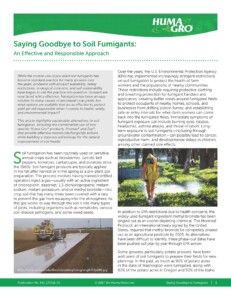Curly fries, waffle fries, spicy fries or… regen fries? Soon, these may all be choices in the frozen foods aisle, at least if McCain Foods has a say in it. And as the world leader in prepared potato products, purchasing 6.8 million tons of spuds annually, McCain carries a strong voice. Their commitment to sustainability includes a pledge to have regen ag practices used on all their potato acres by 2030. The company has entered the Metaverse and designed this virtual game where players grow their own potatoes and learn about regen practices. Thus far, a staggering 2.8 billion visitors—that’s about one-third of the world’s population—have experienced “Farms of the Future.” All-natural, humic-based crop nutrients may soon become a key ingredient in the recipe for regen fries.
Cover crops are growing in popularity. The number of farmers seeding a winter cover is approaching 60%. Yet their motivation may surprise some people. The vast majority of farmers surveyed say they have made no changes in their farming operations due to climate change. Why do they plant cover crops? Improving soil health (37%) and reducing erosion (33%) are the top reasons cited. Only 5% cited carbon sequestration. So financial incentives – whether it’s higher long-term yields, reducing input costs, nutrient management, market access, price premiums and/or increasing land values – outweigh social concerns among farmers. And cover crops provide lots of financial benefits.
The use of biologicals on the farm is trending up, especially among large farmers (>5,000 acres); 20% say they plan to use biostimulants, and 31% plan to use biofertilizers. What’s interesting is the adoption gap between large and medium/small farmers. Large farmers use biostimulants at a 2x greater rate and are 20-35% more likely to use biofertilizers.
Variances among farmers when it comes to adopting other regen ag practices is not as wide. 61% of both large- and medium-sized farmers are employing no-till on their farms (this does not mean they are 100% no-till, just that they are using the practice), while cover crop usage is more consistent among farm sizes. Yet US farmers trail in their adoption of soil-friendly practices and products. In western Europe, 80% of farms use cover crops, while in Brazil 60% use biological products. But now, driven by greater awareness of soil health advantages and rising crop inputs, American farmers are making progress in their adoption rates.
A popular practice by corn growers in many areas is to apply starter fertilizer at planting. Small amounts of nitrogen and phosphorus are delivered in the seed furrow, in a continuous liquid stream, next to the seed. The idea is to enhance early plant development, build early root mass and uniform crop stands by giving the seeds close access to nutrients as they germinate. It’s also a hedge against challenging environmental conditions, such as cool temperatures, and it’s a popular practice for those planting into no-till and heavy residue. As a general rule, the better the soil, the less impact starter fertilizer has on the final yield. In Illinois, where the soil is rich and spring tillage is often used, you don’t see as much of the practice. But the increased popularity in no-till should grow the popularity of starter fertilizers. Currently, US farmers apply about 155 million gallons of starter fertilizer annually. But while popularity of the practice may rise, the amount of fertilizer used could drop dramatically. John Deere is introducing and offering ExactShot technology on their planters. As the name implies, ExactShot delivers a shot of fertilizer directly on the seed, and only on the seed. Sensors register when seeds are being dropped in the soil and robots spray exactly the amount of fertilizer required as the seeds drop. This technology cuts the amount of starter fertilizer required by 60%. Another practice proven to reduce the rate of starter fertilizer is using humic acid at planting. Applying humates can lower starter fertilizer needs by 15% while stimulating root growth and producing higher yields.
Over the past few weeks, ranchers throughout the country have been busy chopping ice. And no, they weren’t making smoothies. Speaking from personal experience, chopping ice is an all-too-common practice among cattle producers during the winter. In cold temperatures, water tanks and lifting lids can freeze over. Ice must be removed for the cattle to drink. As this video shows, cattlemen use picks, metal bars and other tools to chop the ice so cattle can gain access. Nowadays, heated waterers are common—provided you have electricity. On my farm in Illinois, we utilized barns and other shelters for our cattle to access. We spread straw inside the shelter to serve as warm bedding. Keeping animals dry and out of the wind and precipitation is key to keeping them productive and reducing death loss. And before we purchased a heated waterer (next to our big round baler, that may have been my happiest purchase!), we made frequent trips to the barnyard to chip ice and make sure the waterers were accessible. Lactating beef cows can require more than 10 gallons of water per day, so having access to water is critical. While our cattle congregate in the barnyard during cold spells, some ranchers don’t often have that luxury, as they may have many waterers located in remote locations.
Related Posts

Breaking Down COD
By Heather Jennings, PE When I first came into the water field in the 2000s, the general rule of Chemical Oxygen Demand to Biochemical Oxygen Demand (or COD to BOD5) was 2:1. That was pretty much all you needed to know in order to understand whether something could be treated chemically, physically, or biologically. Now, the wastewater industry has moved toward COD instead of BOD5. The reason that COD is...

Saying Goodbye to Soil Fumigants
An Effective and Responsible Approach A New White Paper from Huma Gro® While the routine use of pre-plant soil fumigants has become standard practice for many growers over the years, problems with product availability, safety restrictions, ecological concerns, and soil sustainability have begun to call the practice into question. Growers are now faced with a...

New Fertilgold® Organics Promo Video
There’s tremendous power in nature. What if you could harness that power and put nature’s science to work growing your premium organic crop? To see how, watch this 30-second introductory video for Fertilgold® Organics.

